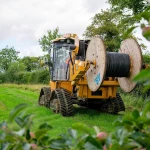UK Mobile Operators in Counter Proposal to Stop National 2G Roaming
The United Kingdom’s primary four Mobile Network Operators (MNO), including EE, Vodafone, O2 and Three UK, are preparing to make a counter proposal to the Government’s demand for a national roaming policy that would see investment boosted in order to build new masts and improve coverage.
The telecoms regulator, Ofcom, currently reports that around 99% of the United Kingdom’s population can already receive both 2G and 3G based outdoor mobile network coverage from at least one operator. But this falls to 73%+ for 4G, although even that will reach a similar level by the end of 2015.
Advertisement
But such figures only present part of the picture because in geographical (landmass) terms even basic mobile connectivity can only reach around 80% coverage, which leaves plenty of so-called “partial notspots” in-between. The Government wants to solve this by effectively forcing operators to improve 2G mobile reception in related areas (i.e. mostly rural locations) through greater sharing of key infrastructure, such as masts (details).
However the Mobile Operators Association warned in September 2014 that such an approach would be “Unworkable … national roaming isn’t the silver bullet that is being suggested. It will take years to implement and will not address the problem of notspots. National roaming would be a disincentive to build more infrastructure. And it is technically difficult and expensive to set up national roaming, and customers would face more dropped calls.”
Never the less the Government think they’re on to a vote winner, thus any arguably legitimate complaints from mobile operators about rivals getting a free ride from their respective investments and thus discouraging future upgrades are likely to be overlooked. On top of that they’re all facing a huge licence fee hike (here), which seems at least partly intended to off-set against lower than expected 4G auction revenues (here).
So it’s little wonder that the big four have decided to produce a counter proposal, which according to The Telegraph would see them investing millions of pounds to boost predominantly rural coverage and eliminate “partial notspots“. Apparently this would push the geographic coverage up to around 89%, although we assume this would still only help basic 2G connectivity and that’s no good for data (we need it for at least 3G / Mobile Broadband too).
Advertisement
An industry source said:
“The consultation gave us a good look at what they really want and we think what we’re going to propose roughly matches the benefits they say national roaming would have without the problems. We’re optimistic the Government will be happy with it.”
However it’s also reported that the operators will seek a reduction in the proposed licence fee hike as a concession from the Government. Sadly we don’t have a clear idea of the sums involved in the offer itself and so it’s difficult to know how everything would balance out. In addition, operators will want to build taller masts that can cover a wider area and this would require another relaxation in the existing planning rules; easier said than done.
It’s important not to forget that the existing £150 million Mobile Infrastructure Project (MIP) is separately working with Arqiva to build new masts at various points around the United Kingdom, which hopes to resolve some of the country’s worst notspots and will benefit around 60,000 premises. But no doubt some gaps will always remain.
The Government’s snap National Roaming consultation is currently open for responses until 26th November 2014 and we suspect that its rushed nature is at least partly due to the approaching General Election. Below we’ve attached a useful image of the currently predicted geographic coverage of UK mobile networks, albeit only via 3G (dark blue) and 4G (light green).

Mark is a professional technology writer, IT consultant and computer engineer from Dorset (England), he also founded ISPreview in 1999 and enjoys analysing the latest telecoms and broadband developments. Find me on X (Twitter), Mastodon, Facebook, BlueSky, Threads.net and Linkedin.
« Detailed Broadband Download Speeds for the Top 20 Fastest UK ISPs

















































Comments are closed